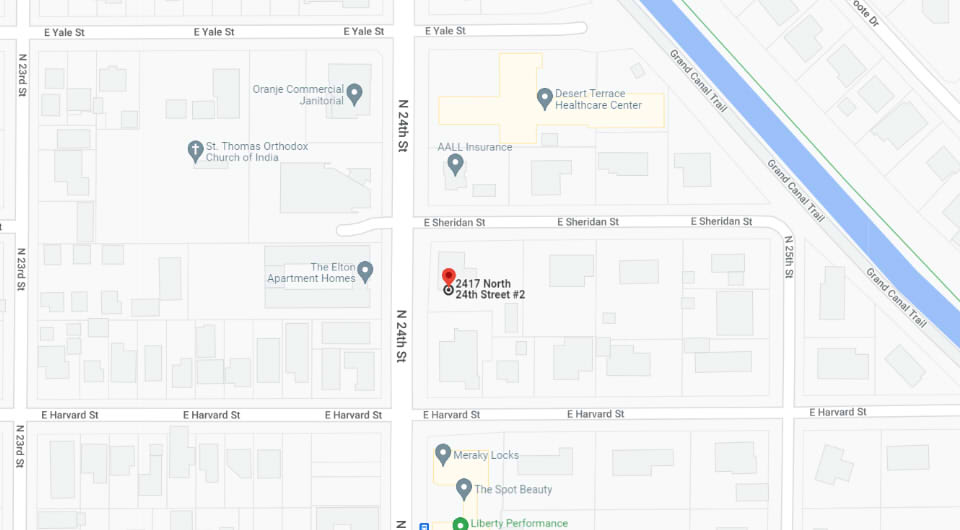All surgeries carry risks and complications. However, most foreseeable risks and complications, including wrong-site injuries, happen when medical professionals are negligent. Wrong-site surgery occurs when a doctor implants a medical device in the wrong location or operates on the incorrect body part. The injuries sustained can be disabling, permanent, and disabling, and you deserve compensation. Phoenix Personal Injury Attorney Law Firm understands your hardships and complications and believes the at-fault medical professional should be held responsible. We can analyze your case and advise you on what steps to take to receive fair treatment and compensation.
Defining Wrong-Site Surgery
Wrong-site surgery is a broad term that entails a surgical procedure performed on the wrong side of the body, an incorrect body part, or at the wrong level of the correctly identified anatomical side.
Wrong-site surgery is a medical malpractice that has several adverse effects on patients who might:
- Undergo a surgical procedure on a healthy body part.
- Lose their healthy and functional body part.
- Suffer a permanent loss of a limb.
- Endure unnecessary scars and wounds.
In addition to this devastating harm, the patient often has to undergo a second surgical procedure to address/treat the underlying health condition that brought them to the healthcare facility.
Wrong-site surgery can have long and short-term effects on a patient. Depending on the form of the surgery, the consequences can include developing infections, permanent changes to your body functions, permanent disabilities, unnecessary scarring, and the need for another surgery.
How Often Do Wrong-Site Surgeries Occur?
A wrong-site surgical procedure is a terrifying and egregious type of medical malpractice. Still, surprisingly, these mistakes happen in about forty surgeries per week in surgical centers and hospitals throughout the United States.
According to one study, there is one wrong-site surgery in every 112,000 surgeries. However, the estimate focused on hospital errors and did not include other settings like clinics and surgery centers.
The Patient Safety Network documents that wrong-side surgeries are the most prevalent form of wrong-site surgical procedures, accounting for 59% of the errors, and 23% are wrong-site mistakes. On the other hand, wrong-procedure errors and wrong-patient surgical procedures comprise 14% and 5%, respectively.
Typically, wrong-site surgical procedures happen in orthopedic surgeries, like operating on the incorrect knee, hip, shoulder, elbow, or wrist. Neurological surgeries associated with the spine are the second most prevalent form of wrong-site surgical procedures, with medical procedures sometimes performed at the wrong level or on the incorrect discs.
Common Liable Parties in Wrong-Site Surgical Procedure Lawsuit
Your personal injury attorney should collect evidence to determine who is accountable for your injuries.
Common defendants in these medical malpractice lawsuits include the following:
The Surgeon
While some surgeons are surgical centers or hospital employees, others are independent contractors. If the negligent surgeon is an independent contractor, you can hold them accountable. In this case, the medical practitioner or their insurance provider should compensate you for your incurred losses.
You will hold the surgeon accountable for this medical malpractice because they are tasked with the following:
- Preparing adequately for the surgery.
- Verifying your medical records and chart.
- Ensuring proper communication with their medical team.
- Making incisions on the correct body part.
Other Medical Practitioners
Sometimes, another medical professional other than the surgeon can be liable for a wrong-site surgical procedure. For instance, a nurse might have mixed up two (2) patients’ charts or given the surgeon the wrong information.
The Healthcare Facility
Vicarious liability is based on the Latin phrase “respondeat superior,” which means “allow the master to speak.” According to this doctrine, another person could be held accountable for somebody else’s wrongful act, including medical malpractice, provided the individual has a higher rank than the defendant. Essentially, the doctrine holds companies lawfully accountable for their employees’ mistakes and actions made within the employment scope.
In this case, hospitals, surgical centers, emergency rooms, or medical centers could be responsible for negligence if the investigation places fault on one of their workers. If the doctor performing the surgery was a hospital worker, the healthcare facility should compensate you.
Filing your lawsuit against the hospital could lead to a significant financial compensation amount than a lawsuit against an individual or a surgeon.
How to Prove a Medical Malpractice Lawsuit
The complexity of medical malpractice laws makes establishing a medical malpractice lawsuit challenging. The plaintiff must overcome hurdles, including the defendant arguing that their treatment was within the standard of care. It would help if you worked with a lawyer or an expert witness to navigate Arizona personal injury law.
To recover compensation for your injuries and the loss incurred, you should prove the following elements of negligence:
- You had a doctor-patient relationship — The doctor-patient relationship exists when the patient goes to a physician for care, and the doctor provides treatment and care.
- The physician was negligent when performing their responsibilities and duties — You should verify that the medical practitioner deviated from the standard of care when treating you. The medical practitioner acted in a manner that a reasonable, similarly qualified medic would not in similar circumstances. You might require a medical expert witness to establish this element.
- The physician’s negligence caused your injury.
- You have actual damages.
Common Damages Awarded in Wrong-Site Injury Lawsuits
After establishing negligence, the amount and type of damages the jury/judge will award you will depend on your injury, recovery prognosis, and severity of the injury.
There are two main types of damages awarded in Arizona medical malpractice claims: economic and non-economic.
Economic Damages
These damages are tangible and have a calculable monetary value.
They can be either future or present costs related to your injuries. Future amounts compensated can be determined through doctor recommendations for ongoing medical attention or expert witness testimony.
Economic damages include:
- Medical bills like emergency room costs, doctor’s appointments, laboratory work, medical equipment, adaptive devices, rehabilitation and physical therapy, occupational therapy, and prescription drugs.
- Lost earning capacity.
- Lost income.
Non-Economic Damages
The jury will award non–economic damages according to what is reasonable and fair based on the case factors. Witness testimony, expert testimony, the severity of your injuries, and the impact of the injuries on your life quantify non-economic damages.
Common non-economic damages include the following:
- Emotional and mental anguish.
- Loss of consortium.
- Loss of life enjoyment.
- Disfigurement.
- Permanent loss of your body part functionality or use.
Other Awardable Damages
You can also be awarded wrongful death damages and punitive damages.
Punitive damages are designed to punish the medical facility or professional that was grossly reckless or negligent when offering treatment. These damages also aim to deter future negligence by other medical experts.
If the wrong-site surgery results in death, the deceased’s estate and family can file a wrongful death claim. The case covers losses and expenses like:
- The benefits that the dead offered.
- The deceased’s lost income.
- Funeral and burial expenses.
How to Maximize Your Compensation Amount
While you are entitled to compensation for injuries and losses suffered after your wrong-site injury, the legal battle to obtain your deserved settlement amount can be complicated. The defendant and their insurance provider might be willing to accept the blame and make a fair settlement for your losses. While it is impossible to eliminate the trauma and emotional distress of your injuries, and every case is unique, understanding the factors determining your claim’s value is critical in your pursuit of a favorable settlement. Here are steps to take to maximize your settlement amount:
-
Collect and Preserve Evidence
The jury will determine your claim by analyzing your evidence. The defendant and their insurer will also determine whether to offer fair compensation based on your case’s strength. The more evidence you gather, the higher your chances of winning your case.
Some of the evidence to collect includes the following:
Medical Records
Your medical records and supporting documentation are fundamental to building your medical malpractice claim. The medical records include doctor’s notes, prescriptions, evaluations, consultation records, and diagnostic test results.
Requesting and accessing your medical records is your first step in collecting evidence.
The Health Insurance Portability and Accountability Act (HIPAA) Privacy Rule establishes standards to safeguard personal health details and medical records. The federal law also gives every patient the right to access their health details and to acquire copies of their medical records.
Personal representatives (parents of a child, executors of the deceased’s estate, or an advocate with written consent) are also entitled to access medical records.
Healthcare providers should not deny or charge the request due to outstanding medical bills. Nevertheless, you can pay for the cost of mailing the records.
You should fill out a form or submit a request to access the medical records. If the office does not have the request form, write a letter that includes the following details:
- Your name, birthday, and Social Security Number.
- Address, email, and phone number.
- Signature.
- A list of your requested health records.
You should contact various medical practitioners, like your surgeon, lab technician, pharmacist, and nurse.
Expert Witness Testimony
The complexity of medical malpractice requires a thorough understanding of medical terminology, Arizona medical malpractice law, and the expected standard of care. Your personal injury attorney should conduct extensive research and work closely with a medical expert witness.
While your expert witness was not present during your wrong-site surgery, they can use their many years of training and experience to collect and review the case facts, analyze your medical records, and listen to the liable party before writing a report with a summary of:
- facts,
- standard care that a reasonable surgeon or healthcare facility would have offered in similar circumstances, and
- whether the defendant deviated from the standard of care.
Proof of Physical Injuries
Proof of physical injuries might include seeing your injuries. You can use photographs of the damage following the wrong-site injury, scars resulting from the medical mistake, or required corrective surgery. For instance, you can show the jury your lost limb following the wrong-site surgical procedure.
Records of Your Damages
Proof showing the total economic damage suffered can assist the jury in determining the cost of the medical error. It involves presenting:
- Your medical expenses.
- Pay stubs.
- Experts’ estimates on future medical costs and loss of income due to your injury.
Your Experience
Mental distress, pain and suffering, and your injury’s effect on relationships can be challenging to verify. Hearing from you can aid the jury in understanding the extent of your non-economic losses. That is why you should keep a journal documenting your pain degree over time and how coping with life-altering changes following the injury has impacted your life.
Other Essential Evidence
Ensure you have detailed records of all medical providers you interacted with during the treatment, including the names of surgeons, nurses, technicians, doctors, and nurses. Write down everything you remember about every conversation. Remember to include the dates of all hospital stays and appointments.
-
Change Your Medical Provider, Continue Seeking Medical Attention, and Follow Your Doctor’s Advice
If your surgeon knows that you want to bring a medical malpractice claim, they can work to reduce the possibility of a successful outcome in your case. Avoid this by finding a new doctor.
Your wellness and health are more essential than any medical malpractice claim, and you should attend all doctor’s appointments and follow your doctor’s advice. Furthermore, keeping up with your treatment will assist your personal injury lawsuit to understand the full extent of your injuries.
-
Hire a Skilled Medical Malpractice Attorney
Most people only understand the importance of hiring a proficient attorney once they need one. Navigating the Arizona legal system can be complicated, making it challenging to receive fair compensation. Having a seasoned and qualified legal professional by your side could make a difference. Here are reasons why you should hire a medical malpractice lawyer:
- Your attorney knows your case’s value — Your lawyer has previously handled similar cases and knows what to seek regarding compensation. They will review your case and work with other professionals to understand how to place value on your case, injuries, and current and future losses, among other factors to consider. Finally, they can precisely present your needs and wants, increasing the likelihood of a favorable ruling at trial.
- They will handle the insurance provider and work on getting the best settlement possible — Dealing with the defendant and their insurer is overwhelming. Most plaintiffs need to learn when to speak with the insurance adjuster and what they should or should not say. An attorney can handle the negotiations with the insurer so that you can pay attention to your recovery.
- They will handle your paperwork — After sustaining a wrong-site surgery injury, the last thing you want is to worry about gathering the relevant paperwork to bring your claim. Typically, medical malpractice claims involve legal jargon and complicated paperwork. Your attorney knows the necessary documents for your case, the best language to use, when to file your lawsuit, and how to respond to the defendant’s correspondence.
-
File Your Claim Within the Statute of Limitations
A statute of limitations is the time limit to file a civil lawsuit after suffering an injury or loss. According to ARS 12-542(1), you have two years to file your claim after the cause of action accrues. The legal term “the cause of action accrues” means when you knew or should reasonably have known that a negligent medical mistake caused your losses or injuries.
Unless exemptions exist, if you bring a claim after the SOL has passed, the defendant will file a motion requesting the judge to dismiss your lawsuit.
Filing your case early also allows you to build your case.
-
Do Not Accept the Insurer’s Initial Offer and Explain Why It is Inadequate
Do not settle too soon. The insurance company will offer you its initial settlement before you have finished receiving medical attention for your resulting injuries. At this stage, you also do not know your claim’s worth. The insurer hopes you will accept the offer early so that the claim is closed.
When you receive an unfair settlement offer, you should tell the insurer why you cannot accept it, with proof that strengthens your assertion. The settlement rejection shows you are committed to receiving your deserved compensation and have a strong case.
Finally, do not sign any agreement without your medical malpractice attorney reviewing the agreement’s terms and conditions.
Find a Skilled Arizona Medical Malpractice Attorney Near Me
As a patient, you trust that your surgeon and medical facility will consider your well-being and safety. When you sustain wrong-site injuries because the individual or hospital was negligent, you can recover compensation for your injuries and losses by filing a medical malpractice case. However, that does not mean the defendant will voluntarily accept liability. Generally, the defendant will investigate the matter and reach an unsatisfactory conclusion. Insurance companies will also fight hard to avoid admitting fault.
Phoenix Personal Injury Attorney Law Firm is committed to fighting for your rights and ensuring you receive compensation that makes you whole again. We can gather medical records, work with other professionals, negotiate with the defendant and the insurance providers, and file a lawsuit against the defendant on your behalf. Call us at 602-641-9589 to schedule your free case review and find out how we can help you.










